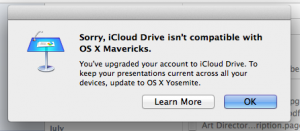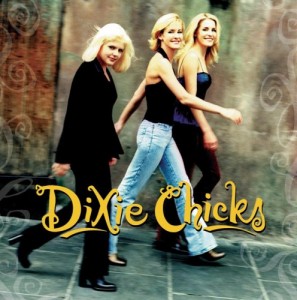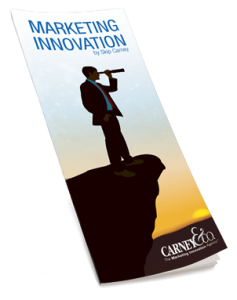Category: blog posts
It was a couple of years ago that I began to suspect things were changing at Southwest. The esprit de corps was missing. No singing during landing or jokes on take-off. Uniforms replaced shorts and golf shirts. Southwest didn’t feel like Southwest. With the introduction of their latest ad campaign, my suspicions have been confirmed. The bean counters have taken over.
A sure sign that the marketing people have lost control of the ship is when the advertising starts to focus on the company instead of the customer. Sadly, it has happened at Southwest Airlines. The great ads that used to feel my pain when I really needed to “get away” have been replaced with images of employees talking about how much they care. They have “heart”. You can tell, it’s painted on the bottom of the planes.
Southwest became great by demonstrating how much they care, not by talking about it.
When you are really good at something, you don’t have to tell anyone. Everyone who matters knows. Can Peyton Manning throw a football? Can Eric Clapton tear up a guitar? The day Adam Levine puts his face on a poster with the caption “I can sing and I’m a really good songwriter, too” is the day he starts playing casinos in the midwest. Of course it applies to great companies, too.
It’s the bean counters, stupid.
Customer-focused innovation separates great companies from the competition. When the bean counters take over, the focus moves to the company and the bottom line. Short term, short-sighted thinking. The real Bottom line. This new campaign does not pass the “So what?” test. “Our people have a lot of heart. We love to fly. We really care about flying around the country.”
So what?
Here’s some insight: We, the customers, fly because we have to. Not because we want to or because it is fun. We like(d) Southwest because you made it fun, or at least tolerable. If you’re going to make it boring, we might as well take the bus.
One of the best ad campaigns of all time was unveiled the day Avis declared “We’re number two, we try harder.” Avis was immediately propelled from the back lot of the airport parking deck to the “front row” in the minds of the car renting public. It was brilliant. Hertz dominated the market and, until that campaign, was the only brand that most people could recall without help. As good a campaign as it was though, Avis never advanced past that number two slot.
Innovation gets the prize
Enterprise looked at the rental car market and saw an opportunity. They opened offices away from the airports and offered to “pick us up.” With all the money they saved from lower real estate costs, they were able to invest heavily in a simple, not-so-clever ad campaign that resonated with an unmet need in the market. “My car is in the shop and I need a ride, and I don’t really want to go to the airport to get a car.” So simple, yet so innovative that Enterprise quickly passed Hertz to become the largest car rental company in America. They now own National and Alamo and they are still growing. Avis, meanwhile, is a solid number three… and slipping. Maybe they should try harder to innovate.
Wherever Steve Jobs is perched as he watches the latest twists and turns at Apple, you know he has to be laughing. The idea that people are upset when they sit on their very thin, very light phone and it bends is too funny for words. It’s almost as good as the countless people who have dropped their phones in the toilet and act like it’s someone else’s fault that they are trying to multi-task in the john. Seriously, people. Don’t mess with your phone when you are messing with your mess. It’s just not kosher.
While Steve may be laughing, he is definitely not smiling.

PC users might be used to sloppy product introductions and instructions that don’t make sense. Mac users, on the other hand, do not suffer fools lightly. So, when we open an iWork document and we get a message that says to upgrade to Yosemite, we expect Yosemite to actually be available for download. When it’s not, we start to miss Steve. It’s this kind of insane attention to detail that made the Apple brand synonymous with user-friendly, common sense, plug ‘n play operation.
Sure, we have now downloaded Yosemite and it’s working beautifully, just as we expect. Meanwhile, the damage is done. A tiny spec of rust on an otherwise shiny brand. It will not be the end of Apple any more than a bent iPhone will be the end of Apple. All it means for now is some of Apple’s raving fans aren’t smiling. And that means Steve isn’t smiling.
It’s a simple fact: Your customers have to pay for your marketing…and they don’t mind at all.
When you market innovation, you are offering a unique solution to your customer’s problems. You are making their lives easier, better, faster, more comfortable and they are happy to pay for that. So, not only do you have to put the cost of marketing into your product, you have to make sure you put enough in there to do the job right.
Companies like Lexus, Apple, Sonos, and Marriott get this. They work with margins that allow for aggressive product develop, exceptional customer service, and (of course) brilliant marketing. It’s the philosophy that “I have to charge you enough to give you the product or service that you deserve.” When you subscribe to this philosophy, you are focused on the customer and the customer experience and not the bottom line. You know that the bottom line will take care of itself.
And there’s more!
The added bonus to all this customer-focused innovation marketing is that the brand is automatically elevated in the marketplace and your customer is even MORE satisfied with her purchase. It’s further confirmation that she made the right decision and confidence that the product and brand will continue to provide value in the future.
So, put enough margin into your product to expand your offering and tell your story completely. We’ll gladly pay for it.
I love Bose. The company produces amazing sound and long ago set the standard for innovation and quality in the world of audio. I love my Wave Radio so much I sent Paul Harvey a letter about it. He read it on his show for over three years.
So when it came time to replace my surround sound system with a sound bar, I naturally wanted a Bose Sound Bar.
I got one, installed it and, of course, loved the sound. The problem was to play music, I had to have my TV on. So, I looked for other options and found my way eventually to Sonos. The Sonos system does NOT sound as good as Bose, but I’m the only one in the house that knows that. Sonos has developed an interface, however that is easy to use, works from my iPhone and iPad, and allows me infinite control over each component without engaging my TV. I am confident Bose is working on a similar system. Unfortunately, it’s too late for me. I have moved on. That’s the way of the world today. When we want it, we want it now. For today, Sonos innovation beats Bose brand. The ball is now in Bose’s court. Meanwhile, their brand and sales are taking the hit.
Marketing is not just about growing. It is also about choice. Sure you want to give your customers choices, but you also want to be able to choose your customers. If you have a steady flow of inquiries and leads, you have more control over the kind of business you take. This is especially true for B2B companies, but it also applies to B2C. Retail and consumer marketers discriminate with price and distribution. Business to business marketers can discriminate with price, type of project, and by sometimes just saying, “No, we don’t think this would be a good fit.”
You can only say “no,” though, when you have options, and the best way to have options is by keeping your message in front of your customers and prospects. This is why the best companies never let their foot off the gas of their marketing or their innovation. Innovation gives you a reason to market and a message that connects. Marketing that innovation communicates value and distinction. When you have that, you can say “yes” to the customers and business that you really want and “no” to the business that isn’t profitable or otherwise doesn’t fit.
Innovation is the buzzword of the century and, while it is laudable to want to be like Apple or Amazon, it’s hardly necessary to reinvent your industry to find success. It IS necessary to market innovation.
Why marketing innovation works.
Simply put, innovation is a creative solution to a customer problem. Big problems, little problems, everybody has them and they all need solutions. Every business is capable of this kind of innovation and most are innovating every day. They just fail to realize or act on that innovation and most importantly, they fail to market it.
Customers want more than just solutions to their problems, they want NEW solutions. They will ALWAYS want new solutions. Tide laundry detergent has been “new and improved” more than 80 times in the past 75 years. Most of those innovations were not earth shattering, but they were significant enough that Tide has maintained its dominance in its category. Look around your company. You have innovation opportunities everywhere. Solve your customers’ problems and then tell them about it. Your brand, market share, sales growth, and profit margin will all follow.
Great brands never forget their customers or how they got them in the first place.
I was flying cross country recently and, scrolling through my iPod for something to help pass the time, I settled on the Dixie Chicks catalog. The first three albums, that is. The ones before they forgot their mission, abandoned their fans, and destroyed their brand.
Yes, even country music singers have a brand, and just like Proctor and Gamble, McDonalds, and your local mechanic, they must protect and nurture that brand or, like the Chicks, go the way of the Dodo birds. The music in the early days was pure, simple and all about ME. I could relate to it. I, like millions of others, understood the joy, pain, irony, and humor in that early music.
After they lost their way, the music became all about THEM. Songs about how mad they were, about how sad they were. All about THEM.
This is why you can only hear the Dixie Chicks on your iPod now and why there will never be another Dixie Chicks album that matters. It is not because they said something stupid in England. It is because they forgot why we liked them in the first place. They forgot their brand.

Albert Einstein once said, “If at first the idea is not absurd, then there is no hope for it.” Steve Jobs took those words to heart. Every innovation he envisioned was at first considered absurd, undoable, and generally far-fetched.
Lesson One: If the idea is right and you know it, it doesn’t matter if everyone thinks it is absurd.
When he conceived the idea for The Apple Store, he took it to his board…all smart, successful people who had witnessed his magic first hand…the immediate response was ‘no way’. Gateway was closing stores left and right and no other computer manufacturer had been able to succeed at retail. The Apple Store is now the most successful retail concept in history. More sales per square foot, more sales per store, more profit, than any other retail store selling anything.
Lesson Two: He never took no for an answer.
iPod and iTunes revolutionized and saved the music industry. As brilliant and beautifully simple as the iPod was, it was just a music player with iTunes. And iTunes would be nothing without the consent of the music industry. One by one, Steve personally visited every major music publisher. One by one, he convinced them to give the iTunes model a try. He hoped to sell one million songs in six months. He sold one million in six days. Even in the light of that early success, there were holdouts. Most notably, the Beatles. He never gave up and in 2011, the Beatles joined iTunes.
Lesson Three: Never stop selling.
Steve Jobs was not just a genius, not just a visionary. There are many geniuses in the world who are unknown and have contributed little to our world. Jobs was different. He was a salesman. A Master Salesman. He believed in his product. He believed in its value. He believed he could help people if he could just help them understand. He kept working until they understood.
This, I believe is the real genius of Steve Jobs. He was smart enough to realize that all good ideas must be sold. And the best ideas have to be sold more.
What I’ve learned from Steve Jobs, so far…Never never never stop selling.
For more evidence that the creative well is running dry in this country, you need look no further than prime time TV. Seriously. And I’m not talking about the countless hours of mindless “reality” programming that have nothing to do with reality. Really. No, I refer to high quality shows that should know better. Two words…really and seriously. I defy you to find a single episode that doesn’t include one or both of these overused, unimaginative, rejoinders. The Closer, Last Man Standing, I even saw it used in a 2004 episode of Deadwood. Really. Apparently this downward spiral started right after Wild Bill Hickock was killed in 1876.
You’ve got to be kidding me? (aka Seriously?). No sh#@! (aka Really!). Somewhere along the way we lost cool, neat, darn straight, hell yeah, what the?, and peachy keen. And maybe we should have. But is really, seriously? the best you got? My college english professor once told me to never use “etc.”. He said it means you can’t think of anything else to say. I think of that a lot when I watch TV. Really. Seriously. It’s time for something new.





